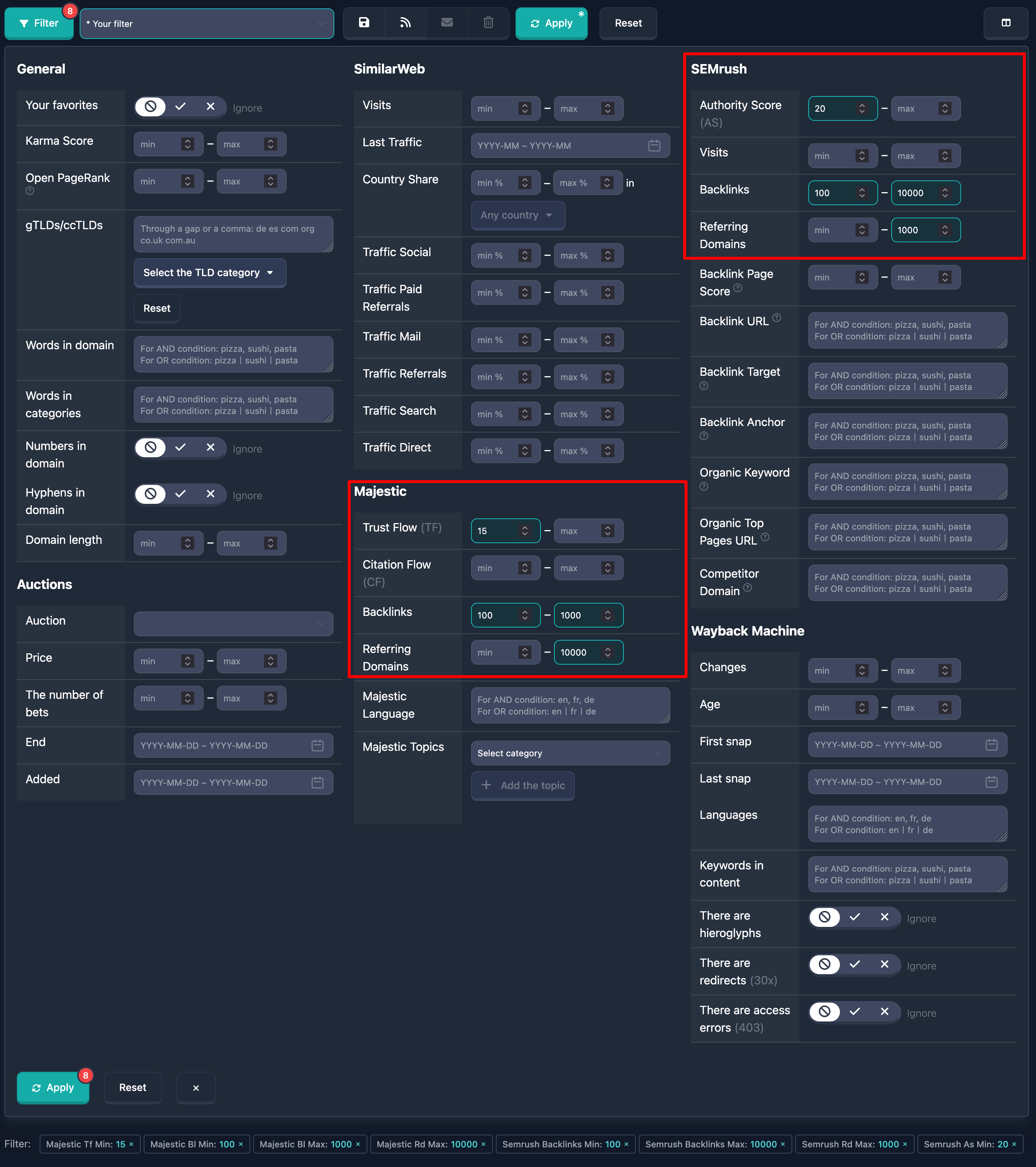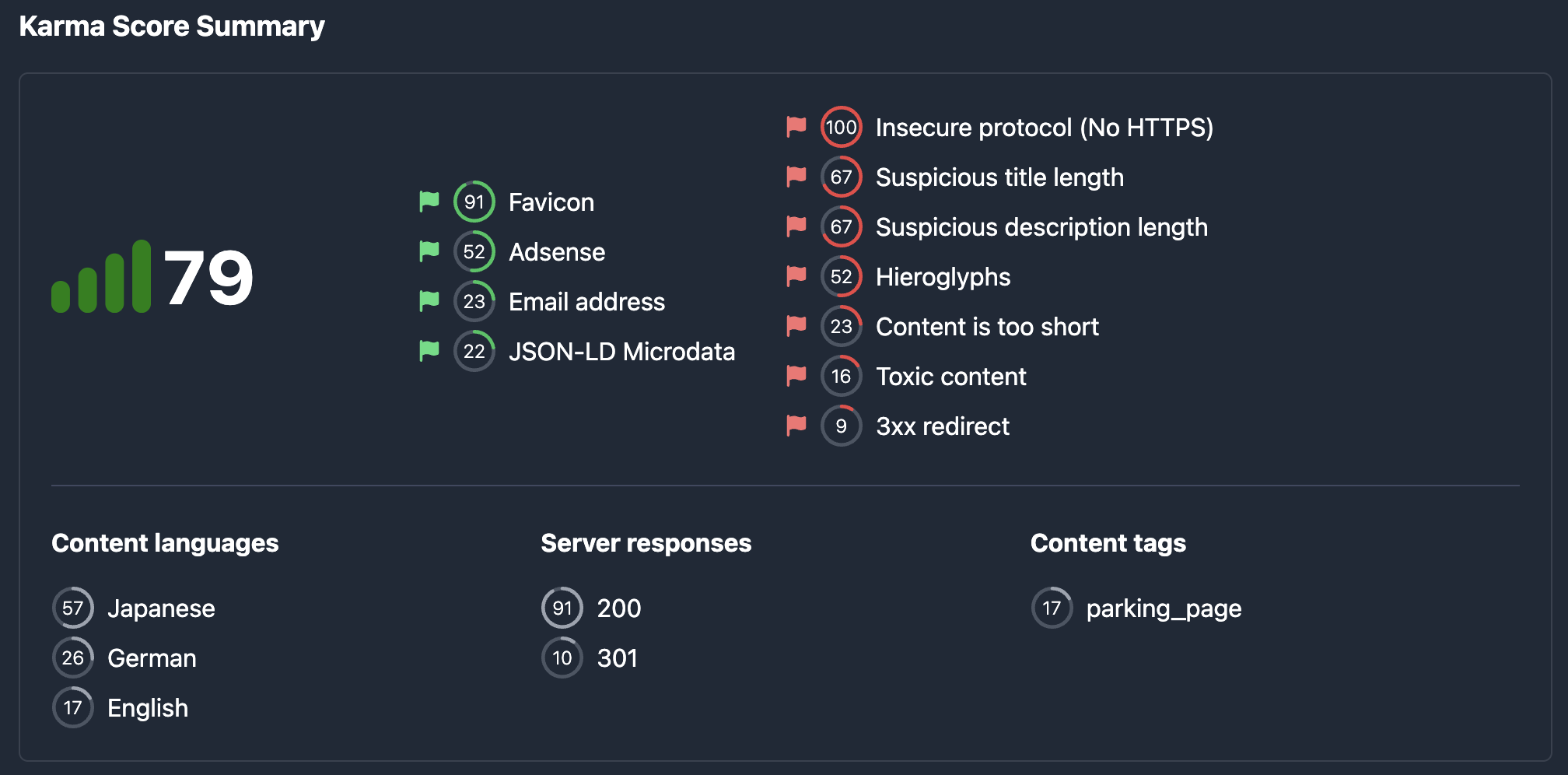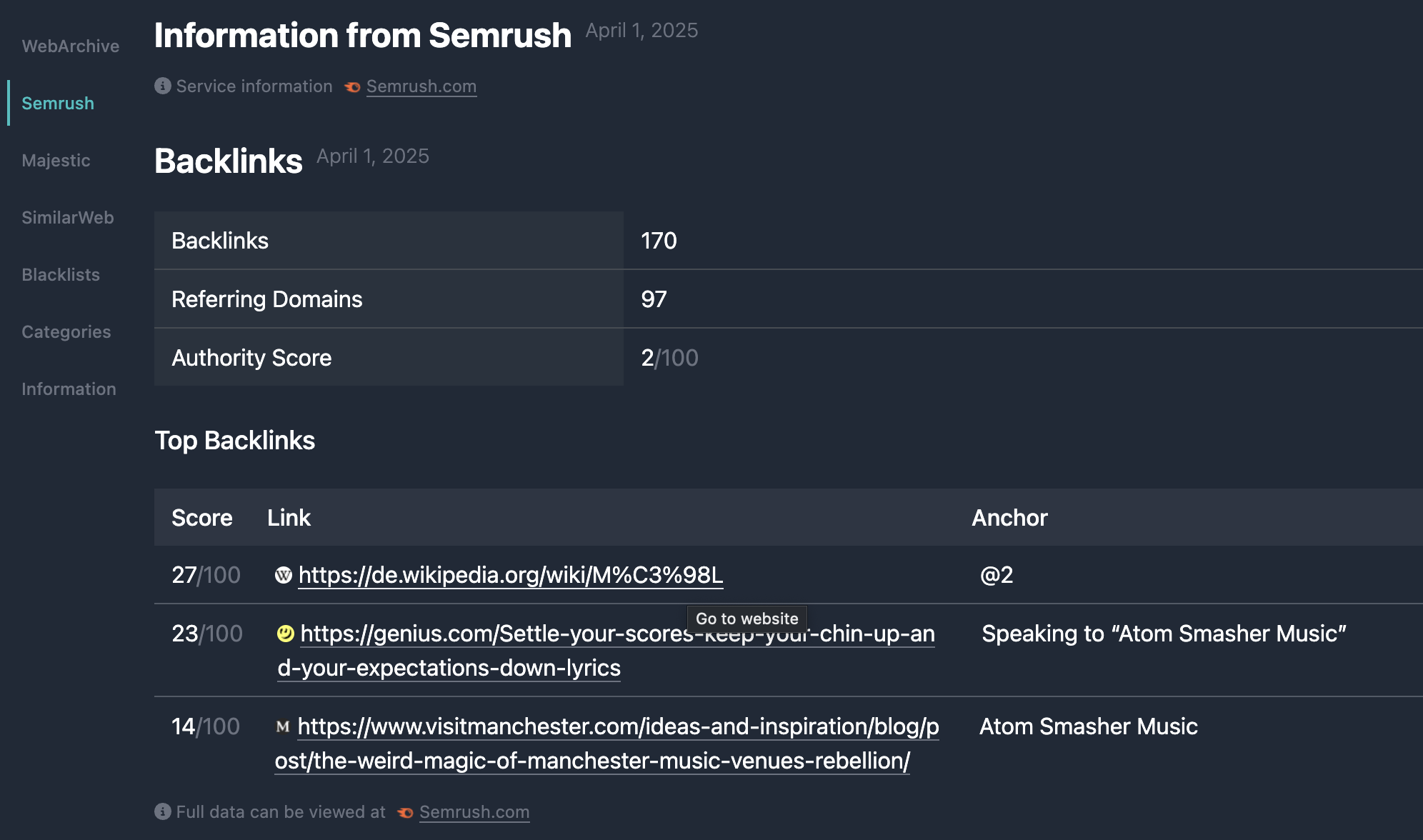A simple, step-by-step guide on how to quickly find expired domains with great backlinks and SEO potential. You'll learn how to set up filters in Karma.Domains, what to look for in Majestic, SEMrush, and Open PageRank metrics, how to manually check content quality in Wayback Machine — and why all this matters when deciding whether to restore a site, launch a new project, or set up a 301 redirect.
Table of Contents
- Table of Contents
- Introduction
- How to Evaluate Backlinks
- Why Language and Relevance Matter
- Types of Expired Domains
- SEO Filters in Karma.Domains
- Setting Up Backlink Filters
- Refining Relevance with Keywords and Anchors
- Filtering Out Toxic Domains
- Manual Domain Review
- Registering and What’s Next
- FAQ
- Can I trust TF, CF, AS metrics?
- Why can’t I find the domain in Google results?
- What’s better: one great backlink or 100 weak ones?
- Should I worry if the domain had redirects?
- How do I know the backlinks won’t disappear tomorrow?
- How much does a good domain with backlinks cost?
- Can backlink checks be automated?
Introduction
Backlinks are one of the biggest ranking factors in Google, Bing, and other search engines. The more quality backlinks a site has, the higher its domain authority and the easier it ranks well.
But not all backlinks are created equal:
- Is the backlink hard to get? Then it’s more valuable.
- Is it placed on a relevant commercial site? That’s better than a link from a generic directory or a blog comment.
The gold standard: backlinks from news sites, government websites, or industry associations — they’re rare and search engines value them highly.
Domain authority is just a way to estimate how much trust a site has built up. Google doesn’t share its formula, but SEO tools (Ahrefs DR, Majestic TF/CF, SEMrush AS) offer their own “proxy” metrics. These aren’t used directly by Google, but they help you quickly filter out junk.
So where do expired domains with great backlinks come from? Businesses shut down, owners forget to renew, brands rebrand… The domain goes to auction — or sometimes just becomes available. The new owner can either rebuild the site or redirect its link juice elsewhere.
How to Evaluate Backlinks
-
Tools: Ahrefs, SEMrush, Moz, Majestic — each has its own backlink database. Google’s is bigger, of course, but it's private.
-
Metrics: These tools estimate things like domain authority. These aren’t part of Google’s algorithm, but they speed up your analysis.
-
Context: Don’t just trust numbers. Also check:
- the language of the linking page,
- the topic/niche,
- the anchor text,
- and where the link appears on the page (visible block? footer?).
Why Language and Relevance Matter
Search engines look for relevance. If a French automotive site gets a link from a Japanese cooking blog — it won’t carry much weight.
- The content language should match your future audience.
- The donor site’s topic and anchor text should naturally support your project’s theme.
Types of Expired Domains
Depending on timing, domains can be at auction or fully available.
| Type | What It Means | Pros | Cons |
|---|---|---|---|
| Auction | In the redemption phase, but being sold | Traffic and backlinks often live | Higher price, more competition |
| Available | Fully dropped and open for registration | Cheap, fast | Good ones are rare, must monitor |
Karma.Domains separates auction and available domains into different sections.

SEO Filters in Karma.Domains
Karma.Domains currently pulls in metrics from Majestic and SEMrush, plus Open PageRank (the public version of classic PageRank). More metrics will be added over time.
Here’s what you can filter:
- number of backlinks (Majestic / SEMrush),
- number of referring domains,
- Trust Flow, Citation Flow, Authority Score, OPR,
- top anchors, keywords, topics.
Setting Up Backlink Filters
All filters in Karma.Domains work using AND logic. If you set 5 strict conditions, you might get zero results. Tip: start with 1–2 filters, see how many results you get, then add more.
- Backlink range:
min 100,max 10000. Higher numbers ≈ higher risk of spammy links. - Referring domains: set a cap ≈ 10% of max backlinks. For example, if backlinks max is
10000, then referring domains should be under1000. This helps catch spam where many links come from just a few domains. - Quality: Majestic
TF min 15or SEMrushAS min 20. Enough to filter out obvious junk.

Save your filter if you plan to search again later.

Refining Relevance with Keywords and Anchors
One of Karma.Domains' unique features is filtering by content from the Wayback Machine. This is super helpful if topical relevance matters to you.
- Enter keywords related to your niche. For example:
carorautofor automotive;skincarefor beauty. - Keep it to 2–3 words max. Too narrow, and you’ll miss good domains.
- Use
|(OR) or commas,(AND) to combine words.
The more broadly used the keyword in your niche, the more results you'll get.

You can also filter by:
- Semrush Backlink Anchor — find domains with links using specific anchor texts.
- Semrush Organic Keywords — filter by search phrases.
This is a powerful way to find expired domains with real SEO potential.
But remember: all filters use AND logic. The more conditions, the fewer results.

Filtering Out Toxic Domains
Regardless of what SEO tools say, some domains are just trash. To block these, set the following:
- Karma Score
min 80
Scores under 50 often show signs of spam, redirects, or hacks.

- Extra checkboxes: “No Chinese characters,” “No 301/302,” “No access errors”

If your results are too limited, try relaxing some settings or lowering the Karma Score threshold.
Manual Domain Review
Each report in Karma.Domains includes a Wayback summary, flag indicators, and Majestic / SEMrush metrics. Here’s what to check first:
- Wayback report — look at language, niche, and content consistency.

- Flag summary — green/red signals on domain history.

-
Ahrefs / Majestic / SEMrush — review top backlinks.
Focus on:
- whether the links are still live;
- link placement (higher on the page is better);
- age of the link.

Karma.Domains doesn’t show full backlink lists from SEO tools — only their metric values. Use those values to filter and sort domains. After that, manually check selected domains using those tools (or alternatives).
Focus on the top 10–20 backlinks first — they usually carry the most “link juice.”
Registering and What’s Next
- Auction: sign up, place your bid, win the domain.
- Available: register instantly through any registrar.
If you're browsing auctions, Karma.Domains lets you filter by bid count and current auction price — so you can focus on domains within your budget.
Then what?
- 301 redirect to your main site.
- Restore old content → wait for indexing → then 301.
- Rebuild the old site and add a link to your main one.
- Launch a new project on the domain.
Which strategy is best? Depends on your goal. Want to quickly pass link juice? Do a redirect. Want a long-term asset? Restore and grow it.
FAQ
Can I trust TF, CF, AS metrics?
They’re estimates from third-party tools — not Google ranking factors. Use them to filter, not as gospel.
Why can’t I find the domain in Google results?
After dropping, domains often fall out of the index. If the history is clean, it should return after registration and content upload.
What’s better: one great backlink or 100 weak ones?
Usually one niche-relevant backlink from a trusted site is better than dozens of spammy ones.
Should I worry if the domain had redirects?
A single redirect from a previous owner is fine. A chain of 301/302 redirects is a red flag.
How do I know the backlinks won’t disappear tomorrow?
Check the age of the link and the health of the linking site. The older and more stable the site, the more reliable the link.
How much does a good domain with backlinks cost?
Auction prices start around $100 but can go into the thousands — it depends on the niche and backlink profile.
Can backlink checks be automated?
Yes. Majestic and Ahrefs offer APIs.
